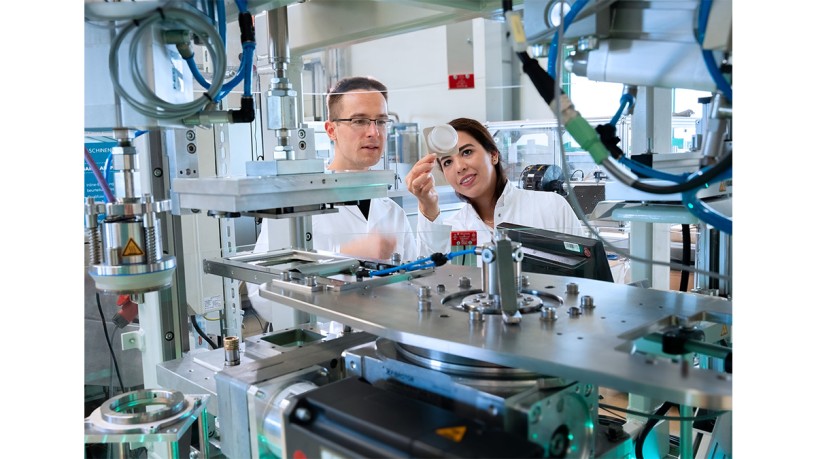About the Potential of Paper-Based Packaging
Mr Köhler, the food industry's interest in barrier papers has increased significantly in the context of the search for alternatives to plastic packaging. What are the main challenges in terms of functionality?
Product protection is of the utmost importance to our customers. This must not be compromised compared to the current packaging. Ideally, barrier papers should also run on existing packaging machines. And finally, the material used needs to be recyclable at a later date. This is not the case with many of today's packaging materials and is often the main reason for choosing barrier papers.
Does the conversion require new packaging equipment or can your barrier papers be run on existing lines?
The issue of machinability also plays a crucial role. Generally speaking, our barrier papers can be processed on existing packaging systems, although minor optimisations are often required. That's why Sappi works closely with packaging machine manufacturers. Changing from conventional materials to new, more sustainable materials often depends on the exact settings of the machines. In most cases, the brand manufacturers' technicians are able to convert their existing lines to paper-based packaging materials such as barrier papers independently.
Barrier papers are generally suitable for dry products. Wouldn't glassine be sufficient for some of them?
The term "dry products" covers a very wide range. Each product has special properties and requires an individual barrier. Glassine, a high-density paper, is largely greaseproof, but does not provide any protection against moisture and cannot be sealed. Barrier papers, on the other hand, offer a combination of optimally adapted protection and functionality.
The functional coating is always on the inside of the barrier paper. The outer side may have a printed line (silk or gloss) or the paper may be uncoated (natural). A manufacturer can then choose the paper that best conveys the image of its product.

©Sappi Europe
How do you test the functionality of the barrier papers?
We use special measuring instruments to test, above all, permeation, i.e. the permeability of oxygen, water vapour or mineral oil components such as MOSH/MOAH. For papers that must at the same time heat-sealable, we also check the achievable seam strength. All these measured values are then listed in the respective data sheets.
What are the relevant legal requirements?
The legal requirements are a central guideline right from the development stage. In the food sector, barrier papers must be suitable for direct product contact. Furthermore, all materials entering our production facilities must be authorised accordingly. We must prove and declare this suitability. As we are not always able to provide this proof ourselves, we work with external test laboratories.
When new EU legislation comes into force, such as the current one aimed at increasing the recyclability of packaging, we naturally comply with it. It is Sappi's policy to ensure that packaging made from our papers is recyclable at the end of their life cycle. However, the decisive factor for us is always the specific needs of our customers.
And how do you check for recyclability?
First of all, our papers are tested in our own laboratory using predefined measuring methods in accordance with CEPI or the PPWR – the Packaging and Packaging Waste Regulation. This enables us to determine at an early stage whether the papers meet the requirements and to make any necessary adjustments. The papers are then sent to accredited external testing laboratories, which issue the corresponding certificates to us. Our customers receive these as reliable proof of recyclability.
How do you approach the topic of sustainability with regard to raw materials?
Sappi owns over 400,000 ha of sustainably managed forests in South Africa. However, we use the raw materials from these forests exclusively for local production – none of the wood is shipped from South Africa to Europe for this purpose. In Europe, we have pulp integration at some of our mills. We source the wood needed for pulp production from within a radius of approximately 150 kilometres of the respective site.
On request, we can also offer our customers certification according to FSC or PEFC. However, this requires full traceability of the goods. In addition to the wood, the individual machines and production facilities must also be certified to ensure that the entire supply chain meets the requirements. Certification then confirms that the material has been processed in full compliance with the required guidelines – from the source to production.
What about prices? Are barrier papers more expensive?
Again, there is no general answer to this question. It depends on the material being compared. The range of materials available today extends from single-layer plastic films to multi-layer laminates, which are not comparable in terms of price. At first glance, barrier papers may appear more expensive. However, it should be noted that some countries offer incentives in the form of bonuses for materials that are easier to recycle. This should be taken into account when considering the total costs. In addition, anyone who puts packaging into circulation must pay a recycling fee that depends on the raw material used. For manufacturers, it is therefore very important whether a barrier paper or a plastic film or laminate is used. Paper-based mono solutions offer an advantage here.
Several manufacturers offer barrier papers. What makes Sappi stand out among them?
Sappi began producing barrier papers over ten years ago. And that has enabled us to build up a level of experience and expertise that not everyone can match. We are currently the manufacturer with the widest range of barrier papers. Thanks to advanced dispersion technology, we produce these so that they can be easily recycled in the paper waste stream. Our offer is rounded off by expert advice to help customers find the right barrier paper. On this solid foundation, we are continuously expanding our already broad portfolio with new products. We develop customised solutions that are precisely tailored to our customers' requirements.
For more information, go to: www.sappi.com




